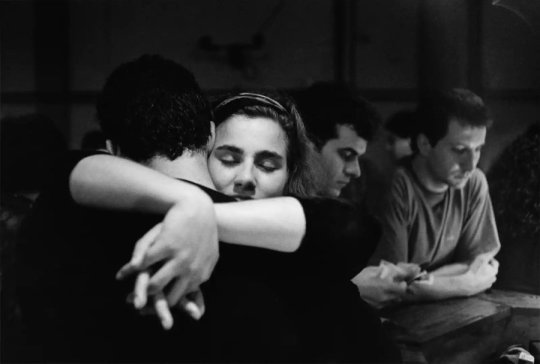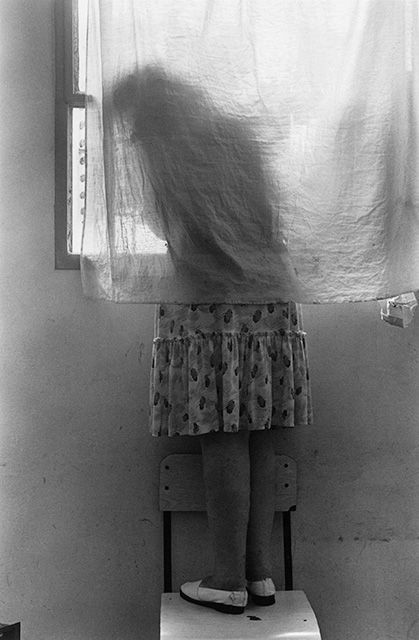#Adriana Lestido
Text

Women in jail, 1992 - by Adriana Lestido (1955), Argentine
205 notes
·
View notes
Photo

Adriana Lestido. From the 'Imprisoned Women' series. 1991-1993
Follow my new AI-related project «Collective memories»
#BW#Black and White#Preto e Branco#Noir et Blanc#黒と白#Schwarzweiß#Adriana Lestido#imprisoned women#imprisonment#carceral#penal#1991#1993#1990s#90s#portrait#Porträt#retrato#ポートレート#portret#面像#초상화
86 notes
·
View notes
Text

Adriana Lestido - La Salsera, 2009
21 notes
·
View notes
Text

Adriana Lestido, Amores difíciles [Difficult loves], 1999
26 notes
·
View notes
Text


http://www.adrianalestido.com.ar/es/polaroids.php
6 notes
·
View notes
Text

Adriana Lestido, selection from Madres adolescentes, 1988-1990
308 notes
·
View notes
Text

Adriana Lestido. From the ''Difficult Loves'' series, 1995-1998.
58 notes
·
View notes
Text

Adriana Lestido's photograph of an Argentine woman prisoner.
From the series Imprisoned Women
Adriana Lestido’s childhood was marked by the absence of her father, who was imprisoned between 1961 and 1966. In 1972, she began studying at the Faculty of Engineering of the University of Buenos Aires where she joined TUPAC, the student branch of Vanguardia Comunista (Argentina’s communist party). There she met the activist Guillermo Enrique “Willy” Moralli, her future husband, who was kidnapped and disappeared in 1978 by the ruling military junta. In 1979, she enrolled in the Escuela de Cine y Técnicas Audiovisuales in the nearby city of Avellaneda. After taking an introductory course in photography, she decided to change her major to focus on that medium.
http://www.adrianalestido.com.ar/en/nota_universo_lestido_miguell_russo.php?desde=notas
He’s Guillermo Enrique Moralli, Willy, an advanced student in engineering and activist in the Vanguardia Comunista; (Communist Avant-guard) a devoted reader of Marx, Lenin and Mao; a union delegate of Molinos (the Mill). She’s Adriana Lestido, nursing student, activist in the Vanguardia Comunista, who loves Pink Floyd and Sartre, and does transcriptions of Psychology theory for a living. In the photo they’re like kids. It’s heard to imagine they’ve been married for 2 years. Even harder to imagine that Willy would disappear only 2 years later on July 18th, 1978. And even harder to imagine, as Adriana says 40 years later that she’s never smiled like that again.

6 notes
·
View notes
Text

Mothers and daughters, 1995-1999 - by Adriana Lestido (1955), Argentine
21 notes
·
View notes
Photo

Adriana Lestido. From the 'Adolescent mothers' series. 1990
Follow my new AI-related project «Collective memories»
#BW#Black and White#Preto e Branco#Noir et Blanc#黒と白#Schwarzweiß#Adriana Lestido#motherhood#1990#1990s#90s#window#fenêtre#Fenster#janela#窓#ventana#okno#창문#窗戶
27 notes
·
View notes
Text

Que sea ahora / Vero (Basada en "La Salsera", de Adriana Lestido)
Si voy a morirme que sea ahora mismo
con tu mano en mi cintura
sin el después donde extrañar
las esquirlas de tu irte.
2 notes
·
View notes
Text
𝐌𝐞𝐫𝐜𝐞𝐝𝐞𝐬 𝐂𝐨𝐭𝐨𝐥𝐢
Childhood, dreams and melancholy are part of Mercedes Cotoli's vision.
In his essay 'Six Walks in the Fictional Woods',Umberto Eco writes about the Time of Misplacement, as the moment when the reader, in this case the spectator, experiences the sensation of being lost in the indefinite prolongation of the story, lost in the labyrinth of possible meanings offered by the author, at which point "time, reverie and memory can merge (...) and the reader's duty is to lose himself" in the narrative.
Born in Buenos Aires, she studied Image and Sound Design at the University of Buenos Aires.
She attended the photo essay clinics of Adriana Lestido, Valeria Bellusci and Shen Wei.
Her first documentary essay Barrerito, in development since 2011, portrays some childhoods in the border between Argentina and Brazil.
Since 2016 she has been running a photography workshop at the 394 School in Barrerito, Misiones, Argentina to bring photography closer to the primary school.
𝘋𝘰 𝘺𝘰𝘶 𝘳𝘦𝘮𝘦𝘮𝘣𝘦𝘳 𝘺𝘰𝘶𝘳 𝘪𝘯𝘪𝘵𝘪𝘢𝘭 𝘪𝘮𝘱𝘶𝘭𝘴𝘦 𝘵𝘰 𝘣𝘦𝘤𝘰𝘮𝘦 𝘢 𝘱𝘩𝘰𝘵𝘰𝘨𝘳𝘢𝘱𝘩𝘦𝘳? 𝘞𝘩𝘪𝘤𝘩 𝘤𝘩𝘢𝘭𝘭𝘦𝘯𝘨𝘦𝘴 𝘥𝘪𝘥 𝘺𝘰𝘶 𝘦𝘯𝘤𝘰𝘶𝘯𝘵𝘦𝘳?
Probably, due to my difficulty in remembering things, what interested me most in photography at the beginning was as a tool of memory. Ever since I was a child I have been interested in the possibility of capturing something of the past and I found in photography a possibility to retain a portion (albeit elusive and partial) of memories.
At the age of 16 I took my first photography course. There I was able to understand more consciously the
possibility of keeping an instant forever.
My biggest obstacle when it comes to photography is learning to wait. I have to work on my anxiety, especially when it feels that the most the present moment is the most important thing in the world, I have to step back and evaluate.
𝘏𝘰𝘸 𝘥𝘰 𝘺𝘰𝘶 𝘦𝘴𝘵𝘢𝘣𝘭𝘪𝘴𝘩 𝘺𝘰𝘶𝘳 𝘤𝘳𝘦𝘢𝘵𝘪𝘷𝘦 𝘱𝘳𝘰𝘤𝘦𝘴𝘴𝘦𝘴?
My work generally arises intuitively from a certain curiosity, somewhat childish, that a bond or a person generates in me.
I am moved by bonds, human relationships,and the creative process has to do with having the time to share and get to know people more deeply, in greater depth
𝘞𝘩𝘰 𝘰𝘳 𝘸𝘩𝘢𝘵 𝘩𝘢𝘴 𝘪𝘯𝘧𝘭𝘶𝘦𝘯𝘤𝘦𝘥 𝘺𝘰𝘶𝘳 𝘸𝘰𝘳𝘬?
Having been trained in the audiovisual field, my main influences are film directors such as Werner Herzog, Aki Kaurismaki, the Danish Dogma 95 with Thomas Vinterberg and Andrei Tarkosvky.
Andrei Tarkosvky has inspired me from the beginning. Lucrecia Martel, an Argentinean filmmaker, was also fundamental in thinking about the importance of talking about our territory.
Two great references in the field of photography are also the American photographer Sally Mann and the Argentinean Adriana Lestido. Both move me deeply.
𝘈𝘳𝘦 𝘺𝘰𝘶 𝘤𝘶𝘳𝘳𝘦𝘯𝘵𝘭𝘺 𝘸𝘰𝘳𝘬𝘪𝘯𝘨 𝘰𝘯 𝘢𝘯𝘺 𝘱𝘳𝘰𝘫𝘦𝘤𝘵𝘴?
I'm finishing the documentary essay Barrerito after almost 12 years, and starting a new one.
Leaving my comfort zone, which is black and white, encouraging me to look in colour.
Both processes of closure and new beginnings have me very excited.
𝘞𝘩𝘢𝘵 𝘩𝘢𝘱𝘱𝘦𝘯𝘴 𝘵𝘰 𝘺𝘰𝘶 𝘸𝘩𝘦𝘯 𝘺𝘰𝘶 𝘧𝘦𝘦𝘭 𝘶𝘯𝘪𝘯𝘴𝘱𝘪𝘳𝘦𝘥, 𝘩𝘰𝘸 𝘥𝘰 𝘺𝘰𝘶 𝘥𝘦𝘢𝘭 𝘸𝘪𝘵𝘩 𝘪𝘵?
The first thing I try to do is not to fight with myself for not taking pictures and to understand that it is also necessary to rest my gaze.










A good way to wait to find something that awakens my curiosity is to read.
I find that reading is an excellent trigger for the imagination, which tends to rekindle that curiosity and the desire to tell new stories.
#mercedes cotoli#photography#culture#art collective#photomagazine#art#london#bnwphotography#female photographers
10 notes
·
View notes
Text
TP#3: Especies de espacios/personajes.
Indagar, describir, imaginar escenarios posibles.
Como venimos mencionando en entregas previas, la naturaleza tendrá un gran peso narrativamente. Será el refugio y el escape que buscan los dos personajes principales.
Abarcará varios espacios como los cuerpos de agua, las orillas del río o sus zonas aledañas verdes y arboladas.
En el último tiempo, estuvimos recorriendo Punta Lara e Isla Paulino, para conocer las locaciones y ver si se adaptan a lo que queremos en nuestro proyecto.
También, buscamos trabajar en espacios más cercanos con la ciudad y lo urbano, como lo son los interiores del micro y la lancha; estos medios transportan a nuestros personajes desde la ciudad hacia la naturaleza y son aquel puente narrativo que separa ambos mundos.
Además, espacios como la carpa tendrán un rol importante, ya que allí dormirán, charlarán y beberán; y, a nivel producción nos es de fácil acceso porque las escenas que se desarrollan en ésta no es necesario rodarlas sí o sí en el río, sino que podemos adaptarlas a algún patio con mucho verde en ciudad de La Plata.
Espacios a trabajar:
Espacio micro: Es el lugar que nos ofrece uno de los primeros acercamientos hacia los personajes. El espacio estará retratado con pequeños fragmentos, tales como las manos de Candela leyendo, la ventana por donde se ve el exterior en movimiento con colores y formas indefinidas, y por último a ambos protagonistas sentados juntos, ella leyendo y él mirando por la ventana. Es un espacio que quisiéramos que empezara a entablar ese pasaje hacia el cambio que ambos están buscando. La idea de dejar detrás algo que uno de ellos está duelando.

Fotografía de Adriana Lestido. Serie “El amor” (1992)

Close, Lukas Dhont (2022)

Matthias et Maxime, Xavier dolan (2019)

Past Lives, Celine Song (2023)
Espacio lancha: La lancha será el nexo que una tanto la ciudad al río como el principio y el final del relato. En términos de producción utilizaremos la lancha que va desde la escollera de Berisso hasta la Isla Paulino. Será un espacio reflexivo para los personajes, donde intercambiarán miradas y darán un comienzo y un cierre al viaje. Será aquel espacio donde los veremos adaptarse y cambiar.

El viaje de Chihiro. Hayao Miyazaki (2003)

Aftersun (2022)
Espacio Carpa: este espacio particular funcionará como un descanso, tanto para la narración como para sus personajes protagonistas. Allí ocurrirá el diálogo más extenso de todo el corto, una charla entre Lisandro y Candela muy distendida. Es un espacio acotado en extensión, donde sus cuerpos serán parte del mismo.

Strawberry Mansion (2021)

Prueba de tesis, escena 9
Espacio máquina de pochoclo: La máquina de pochoclos nos resulta interesante por los mecanismos que tiene que son visibles a través del vidrio. Lo construiremos como espacio al tomar distintos detalles de la máquina, sus movimientos, colores y texturas. Esto mismo llamará la atención del personaje. Aunque es un espacio pequeño e imposible de habitar físicamente, lo incluimos como espacio ya que se convierte en uno al ser observado por nuestro protagonista, a través del vidrio puede ver todos los componentes y procesos de producción de pochoclo. Narrativamente es funcional al relato, ya que es donde el personaje da evidencia de su estado de duelo y por momentos desconexión con lo que pasa frente suyo, ya que aunque está en una calle rodeado de sonidos se abstrae.

Espacio Plaza del camping: La pequeña placita aparecerá de noche en el corto, en el momento más onírico y experimental a nivel realizativo dentro de la obra. Allí nuestro protagonista se encontrará con una misteriosa sombra, y será empujado por una fuerza que no lo dejará avanzar a pesar de su voluntad de hacerlo. Este espacio será amplio y con pocas fuentes de luz, será trazada su longitud por el cuerpo de Lisandro que retrocede hasta caer frente a la carpa. Su función será la de alojar el momento de mayor tensión dentro del relato.

Espacio bosque: Aquí los personajes pasan bastante tiempo, paseando y perdiéndose. La naturaleza del bosque será muy importante en el relato, y nos interesa mostrarla tanto en sus detalles como en planos más generales.

Sharp Objects (2018)

Espacio playa del río: La playa que debería ser un lugar de descanso para los personajes no lo será para Lisandro, ya que se encontrará con un personaje propio del lugar, que escribe sobre la arena con un palo, que le llamará la atención y le impedirá dormir. En términos de producción todavía estamos definiendo que playa del Río de La Plata será donde se lleve a cabo esta escena.

Prueba tesis, TP1.
Espacio cuerpos de agua: Los espacios construidos por el agua nos parece importante señalarlos ya que nos interesa trabajar su imagen y sonido plásticamente, jugar con sus movimientos y reflejos. Tanto a nivel realizativo como narrativamente, serán los momentos donde nos tomaremos más libertades dentro del guión estructurado, y jugaremos con lo experimental.

Lazzaro Felice (2018)

0 notes


